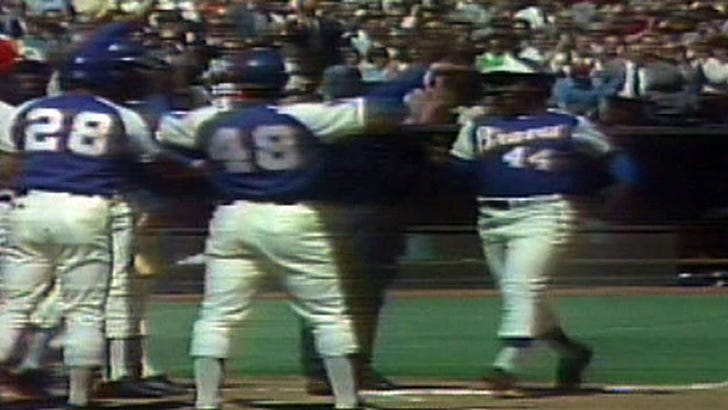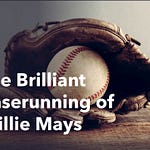INTRODUCTION
Before I share the details of my trip into the past today, I need to provide the background on this story that was about 40 years in the making.
714 was a magical number to me and millions of baseball fans when I was a kid in the early 1970s.
There was no other number in baseball, maybe in all of sports, at that time, that was so revered.
714 was Babe Ruth’s career home run total.
The incomparable Babe had left such a mammoth mark in the record books that 2 generations after he retired, 714 still stood at the top of the all-time home run list, so far above the rest that it seemed like an immovable monument.
714, that hallowed home run record, was the number that symbolized Ruth’s greatness.
How could someone have hit 714 home runs? It seemed even more incomprehensible when considering the fact that Ruth reached that number while hitting less than 50 home runs by the time he turned 25 years old because he started out as a pitcher in the dead ball era. By the way, Ruth was the best left handed pitcher in the American League.
714 had been perched at the top of the all-time HR list since the Sultan of Swat slammed his last ball over a fence on May 25, 1935 in Pittsburgh during Ruth’s final stint in the majors with the Boston Braves.
Incidentally, Ruth hit 3 home runs in that game, at age 40, becoming the first player over 40 ever to do that (it wouldn’t be done again for another 27 years until Stan Musial in 1962).
Ruth’s 3-homer game shared the headlines across the country in newspaper sports sections the next day with Jesse Owens, who on the same day had broken 3 world records in one hour at the Big 10 track meet.
A week later, when his batting average had dipped to .181, and he was suffering with a knee injury, the Babe called it a career.
And thus his final career total had settled in at 714.
After Ruth played his last game, on May 30, 1935, the all-time home run list looked like this with the Babe having doubled the nearest player, and tripled the number 8 player:
714 Babe Ruth
359 Lou Gehrig
300 Rogers Hornsby
276 Jimmie Foxx
251 Cy Williams
245 Al Simmons
244 Hack Wilson
220 Mel Ott
213 Goose Goslin
213 Chuck Klein
Nearly everyone who looked at that list in 1935 must have surely thought that the mark of 714 home runs could never be eclipsed.
A generation later, Ruth’s total of 714 still stood seemingly out of reach of anyone.
Here was the all-time HR list prior to the 1960 season:
714 Babe Ruth
534 Jimmie Foxx
521 Ted Williams
511 Mel Ott
493 Lou Gehrig
429 Stan Musial
369 Ralph Kiner
368 Duke Snider
361 Joe DiMaggio
359 Johnny Mize
But then in the late 1960s, 2 incredible players, Willie Mays and Hank Aaron, who had started their careers in the early 1950s, passed the 500 home run mark and kept going.
For the first time since Ruth had retired, there was discussion that Willie Mays or Hank Aaron could possibly play long enough to catch Babe Ruth on the all-time list.
On August 17, 1966, Mays hit his 535th career home run to pass Jimmie Foxx and move into 2nd place all-time. At 35 years old, and needing just 179 more home runs to catch Ruth, serious debate began on the topic.
In the August 18, 1966 Knoxville News Sentinel, sports editor, Tom Siler, dedicated his daily column to the question. His piece was titled, “Can Willie Catch Babe?”
Mays certainly seemed like he had a chance. He had hit 52 home runs the prior season and was in the midst of a 37 home run campaign in 1966.
Then Father Time caught up with Willie. Injuries and the year of the pitcher limited him to 22 HRs in 1967 and 23 in 1968.
In 1969, more injuries to Mays limited him to just 13 homers at age 38. And that pretty much closed the book on any talk of Mays reaching Ruth’s record.
3 years younger than Mays, Hank Aaron drilled his 500th home run at age 34 on July 14, 1968. This represented a changing of the guard in the race to catch Ruth. A UPI article suggested that, “Aaron’s age gives him a more realistic chance to challenge Ruth’s 714.”
Aaron went on to hit 44 home runs in 1969. And while the pair of Mays and Aaron were edging closer to Ruth, only Aaron was on a trajectory to realistically catch the Babe.
Here was the all-time HR list prior to the 1970 season:
714 Babe Ruth
600 Willie Mays
554 Hank Aaron
536 Mickey Mantle
534 Jimmie Foxx
521 Ted Williams
512 Eddie Mathews
511 Mel Ott
509 Ernie Banks
493 Lou Gehrig
Hank Aaron opened the 1970 season on a tear. He had 17 home runs by June 2nd. At age 36, he was now at 571 home runs.
This prompted the great New York Daily News sports writer, Dick Young, to dedicate his column on June 14, 1970 to the question of whether Aaron could catch Ruth. Young titled his article, “Can Hank Aaron Outlast the Ghost of Babe Ruth?” Young concluded that, “Hank Aaron has an outside shot at hitting as many homers as Babe Ruth.”
Young framed it as an “outside shot” because of the fact that if he were to play 4 more seasons, including the current one, he would have to average 40 home runs per year to catch Babe.
Aaron finished the 1970 season with 38 home runs, 2 short of the pace Dick Young had suggested was required. Aaron now had 592 homers.
Then in 1971, at age 37, Aaron had a remarkable campaign. Playing in just 139 games, and with only 495 at bats, Aaron hit 47 home runs, a career high.
At the start of the 1972 season the top 3 all-time home run leaders were as follows:
714 Babe Ruth
646 Willie Mays (age 41)
639 Hank Aaron (age 38)
Mays was nearly finished as a player and was traded to the Mets to close out his career.
But Aaron was coming off a monster season and suddenly talk of reaching Ruth accelerated.
When Aaron hit 34 home runs in 1972 that left him just 41 shy of the Babe coming into the 1973 season.
In the middle of 1973 it seemed that Aaron would pass Ruth before the end of the season.
On July 8th, in his last game of the season in New York, he blasted home runs number 695 and 696. His reception, in the same city that Ruth had played the majority of his career, was nothing shy of total support. Joseph Durso wrote in the New York Times on July 9, 1973, “(Aaron) received a standing ovation when he left for a pinch runner in the 8th inning.”
He had 28 home runs at the end of July.
When he hit 2 homers on September 3rd he stood at 708 with 22 games left in the season.
But Aaron could only manage 4 home runs from September 4 - September 28 to put him at 712, 2 shy of the Babe with 2 games to go.
Then he hit number 713 in the 2nd to last game of the year.
This set up a chance to tie Ruth in the final game of the season on September 30, 1973.
40,517 fans came out to Atlanta Stadium to watch an otherwise meaningless game against Houston as both teams had long ago been eliminated from the playoffs.
Aaron had a good game, hitting 3 singles, and the Braves won the game, but there was no home run.
Aaron had been the victim of a pitcher, Dave Roberts, who didn’t want to go into the history books as giving up number 714. Aaron told the Atlanta Constitution, “I thought I had one good strike from him… he refused to throw one down the middle.”
And so began the longest offseason of Hank Aaron’s life.
Sitting at 713 home runs to Babe’s 714, it was really just a matter of waiting for 1974 to begin.
It was also a matter of living until 1974.
On October 21, 1973, NBC ran an hour long special, narrated by Tom Brokaw, titled, “The Long Winter of Henry Aaron.” The show presented Aaron in a very positive light as a kind-hearted, humble man. It also documented the “racially oriented hate mail” he sadly had to endure.
As spring training began, a circus-like atmosphere enveloped Hank Aaron as documented in the Long Beach Independent by sports writer Bud Tucker who was reporting from Florida, “He is a parade. Strung out behind him is an impersonal entourage of journalists, cameramen, soundmen, agents, advisors, trainers and tourists.”
Braves manager Eddie Mathews said, “I’m a little concerned about the possibility of a kook, a weirdo, coming out of the crowd to do something to Hank.”
The wait finally ended when the Braves came to Cincinnati to play the earliest opening game in National League history on Thursday, April 4, 1974.
Of course, as The Sports Time Traveler™ I just had to go back in time to experience this.
CINCINNATI - April 4, 1974
I’m here in Cincinnati virtually, where it’s sunny and 63 degrees, delightfully warm for an early April day in Ohio. 52,174 fans have jammed into Riverfront Stadium in Cincinnati, the largest opening day crowd in Reds history. Vice President Gerald Ford is one of those fans in the stadium.
It’s 2:39pm ET and Hank Aaron has stepped into the plate against Reds starter Jack Billingham for his first at bat of the 1974 season.
Aaron has 713 home runs. Babe Ruth has 714.
Braves leadoff man Ralph Garr is on 2nd having arrived there after a walk and single by the Braves 2nd batter Mike Lum.
Hank looks at the 1st pitch. It’s low and away for a ball.
He looks at the 2nd pitch, again low and away.
He takes the 3rd pitch and it’s right down the middle for a called strike.
Aaron looks again at the 4th pitch. It’s another ball low and away.
The count is now 3 balls and a strike.
Let’s look at the video for the next pitch:
Hank Aaron has hit hit home run number 714 on his first swing of the season!
He has tied the great Babe Ruth.
An ovation erupts in Cincinnati and it’s lasted for 6 minutes.
And how ironic is that the only 2 men to ever hit 714 home runs both hit number 714 while wearing a Braves uniform.
================================================================
It is now later in the day and the news has spread across the country. Let’s hear how Walter Cronkite just reported it.
POSTSCRIPT
The Sports Time Traveler™ will continue following Hank Aaron until he hits number 715. When that happens I will report to you again.
I can’t wait!
Thanks for reading.













Share this post